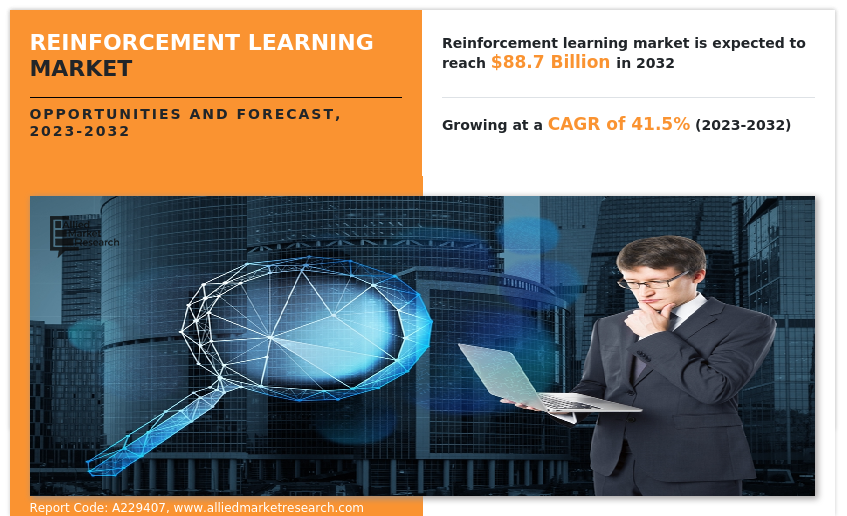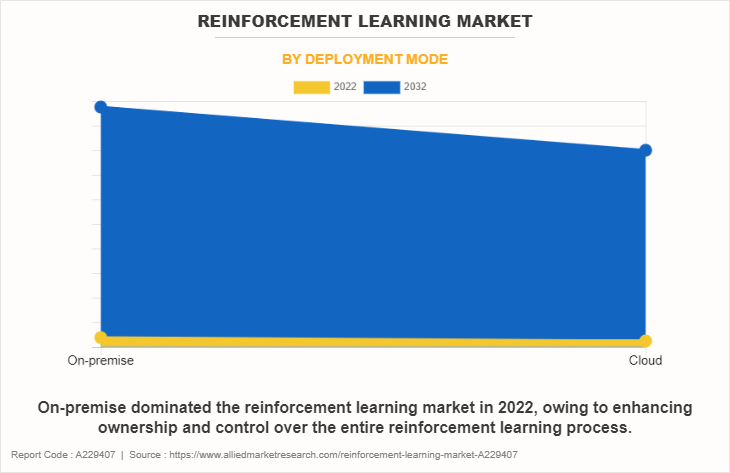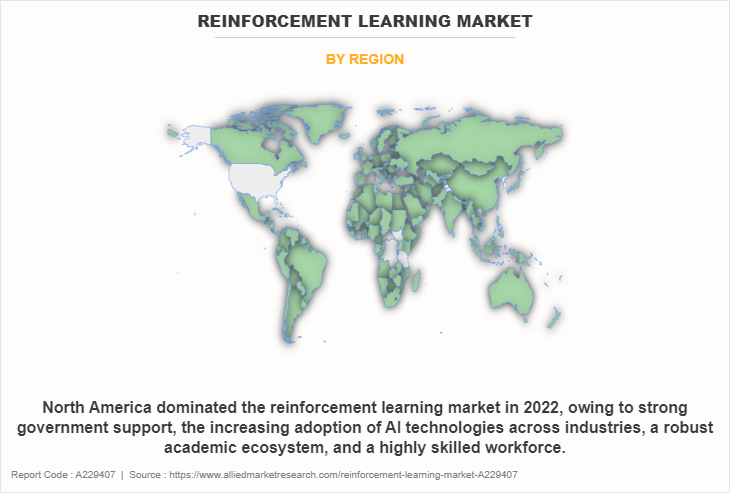Reinforcement Learning Market Insight, 2032
The global reinforcement learning market was valued at $2.8 billion in 2022, and is projected to reach $88.7 billion by 2032, growing at a CAGR of 41.5% from 2023 to 2032.
Reinforcement learning market is expected to witness notable growth during the forecast period, owing to growth in technological advancements and rising demand for solutions driven through artificial intelligence. Moreover, an increase in the use of automation and optimization in multiple sectors is expected to provide a lucrative opportunity for the growth of the market during the forecast period. On the contrary, correlations between the environment limits the reinforcement learning market growth.

The research, application, and commercialization of reinforcement learning algorithms, platforms, and solutions are the main objectives of the reinforcement learning market, which are viewed as a subsegment of the artificial intelligence (AI) business. A device learns to make decisions and take actions in an environment based on input it receives in the form of rewards or penalties through a process known as reinforcement learning. Businesses and organizations use reinforcement learning techniques to automate difficult decision-making processes and improve results in a variety of industries, including robotics, gaming, finance, healthcare, and transportation. Reinforcement learning includes a variety of software tools, platforms, and frameworks that permit the creation and instruction of reinforcement learning models. These tools include features for designing algorithms, preparing data, simulating, and evaluating models. Hardware elements such as GPUs and specialized accelerators are available in the market, which improves the functionality and effectiveness of reinforcement learning systems. The industry includes products and services such as consultancy, training, and support that help businesses install and efficiently use reinforcement learning technologies.
The reinforcement learning market is segmented on the basis of deployment mode, enterprise size, end user, and region. On the basis of deployment, it is bifurcated into on-premises and cloud. On the basis of enterprise size, it is divided into large enterprises and small and medium-sized enterprise. On the basis of end user, it is fragmented into BFSI, IT and telecom, retail and e-commerce, healthcare, government, automotive, and others. On the basis of region, it is analyzed across North America, Europe, Asia-Pacific, and LAMEA.
The global reinforcement learning industry is dominated by key players such as Microsoft Corporation, SAP SE, International Business Machines Corporation, Amazon Web Services, Inc., SAS Institute Inc., Google LLC, Hewlett Packard Enterprise Development LP, Intel Corporation, Cloud Software Group, Inc., and Rapidminer. These players have adopted various strategies to increase their market penetration and strengthen their position in the reinforcement learning industry.

On the basis of deployment mode, on-premise segment dominated the reinforcement learning market size in 2022, owing to improved privacy and security, decreased latency, and more control over the training and deployment process. Organizations fully own and control their reinforcement learning models by utilizing on-premises technology, assuring data protection and security compliance. However, cloud segment is expected to witness the highest growth, owing to organizations quickly scale their computational resources with cloud-based infrastructure in accordance with the requirements of their reinforcement learning models.

Region-wise, North America dominated the reinforcement learning market share in 2022, owing to strong government support, the increasing adoption of AI technologies across industries, a robust academic ecosystem, and a highly skilled workforce. However, Asia-Pacific is expected to be the fastest growing, owing to increasing deployment of AI technology across sectors is one of the major factors boosting reinforcement learning in the Asia-Pacific area. Reinforcement learning has the potential to help businesses in industries including finance, healthcare, manufacturing, and transportation optimize their processes and increase productivity.
Top Impacting Factors -
Growth in Technological Advancements
A major factor propelling the expansion of the reinforcement learning market is advancements in technology. More advanced and efficient reinforcement learning methods are now available owing to the ongoing development and advancement of artificial intelligence (AI) and machine learning technology. The development of better potent algorithms and models that process and analyze complicated data sets are now developed. This enables machines and systems to learn from their mistakes and enhance their performance while receiving feedback and rewards from their surroundings. Large datasets and computational resources are readily available, allowing for more accurate and thorough training of these algorithms, which improves decision-making in challenging and dynamic contexts.
In addition, technical developments have created software platforms and tools that are more effective for developing and deploying reinforcement learning models. These platforms give companies the tools and resources they need to integrate reinforcement learning into their operations. It gives companies the ability to streamline operations, enhance results, and increase productivity. Another factor boosting the development of the reinforcement learning market is the rising demand for intelligent and autonomous systems across numerous sectors. Businesses are starting to realize reinforcement learning’s potential to improve decision-making procedures and optimize results. They are spending money on the creation and application of reinforcement learning technologies as a result.
Rising Demand for Solutions Driven Through AI
Several companies have initiated to acknowledge the value and promise of AI in enhancing their workflows, decision-making procedures, and overall effectiveness. Through a process of trial-and-error learning, the AI subfield of reinforcement learning provides special capabilities for resolving complicated issues and improving decision-making. Due to this, demand for reinforcement learning applications has significantly increased across a variety of industries, including healthcare, finance, robotics, gaming, and autonomous systems. For instance, reinforcement learning is frequently used in the healthcare industry to improve patient monitoring, drug development, and treatment schedules.
Reinforcement learning models are highly suited for personalized medicine and enhancing patient outcomes due to their capacity to learn from data and modify their behavior over time. Reinforcement learning also be applied in the financial sector to create trading algorithms that adjust to changing reinforcement learning market circumstances and maximize profits. Many other industries' needs for such AI-driven solutions have resulted in a rise in research and investment in reinforcement learning technologies, which fuel the market's expansion.
Key Benefits for Stakeholders
- This report provides a quantitative analysis of the market segments, current trends, estimations, and dynamics of the reinforcement learning market analysis from 2022 to 2032 to identify the prevailing reinforcement learning market opportunities.
- The market research is offered along with information related to key drivers, restraints, and opportunities.
- Porter's five forces analysis highlights the potency of buyers and suppliers to enable stakeholders make profit-oriented business decisions and strengthen their supplier-buyer network.
- In-depth analysis of the reinforcement learning market forecast to determine the prevailing market opportunities.
- Major countries in each region are mapped according to their revenue contribution to the global market.
- Market player positioning facilitates benchmarking and provides a clear understanding of the present position of the market players.
- The report includes the analysis of the regional as well as global reinforcement learning market trends, key players, market segments, application areas, and market growth strategies.
Reinforcement Learning Market Report Highlights
| Aspects | Details |
| Market Size By 2032 | USD 88.7 billion |
| Growth Rate | CAGR of 41.5% |
| Forecast period | 2022 - 2032 |
| Report Pages | 278 |
| By Deployment Mode |
|
| By Enterprise Size |
|
| By End User |
|
| By Region |
|
| Key Market Players | Amazon Web Services, Inc., SAS Institute Inc., Intel Corporation, RapidMiner, Hewlett Packard Enterprise Development LP, Google LLC, SAP SE, Microsoft Corporation, Cloud Software Group, Inc., International Business Machines Corporation |
Analyst Review
The reinforcement learning market is an area of artificial intelligence (AI) that is expanding significantly due to the rising demand for intelligent automation and decision-making capabilities across sectors. An agent learns to make decisions and take actions in an environment based on rewards or penalties through the use of reinforcement learning which is a subtype of machine learning. Moreover, the software tools, platforms, and services included in this industry permit the creation, instruction, and implementation of reinforcement learning models and applications. In addition, the market is expanding significantly as a result of various causes. Organizations are continuously searching for ways to use autonomous systems that learn and adapt to optimize complicated processes, increase productivity, and produce better results. A strong foundation for resolving these issues is provided by reinforcement learning. In addition, more complex reinforcement learning algorithms are developed as a result of advancements in AI technologies, specifically deep learning and neural networks. Furthermore, technology has increased the applications of reinforcement learning across multiple sectors.??
For instance, in March 2020, ABB partnered with Silicon Valley AI start-up, Covariant, to bring AI-enabled robotics solutions to market, starting with a fully autonomous warehouse order fulfillment solution. This partnership brought together the two companies with a vision for robotics enabled by AI, where intelligent robots work alongside humans in dynamic environments, collectively learning and improving with every task completed. Covariant’s software enables robots to engage in reinforcement learning: adapting to new tasks on their own through trial and error and therefore constantly broadening the range of objects they pick. This partnership also aimed to expand into new growth sectors such as distribution and e-commerce and to leverage the scaling potential in these fields.
The Reinforcement Learning Market was valued at $2,816.51 million in 2022 and is estimated to reach $88,694.87 million by 2032, exhibiting a CAGR of 41.5% from 2023 to 2032.
North America is the largest regional market for Reinforcement Learning Market
The global reinforcement learning industry is dominated by key players such as Microsoft Corporation, SAP SE, International Business Machines Corporation, Amazon Web Services, Inc., SAS Institute Inc., Google LLC, Hewlett Packard Enterprise Development LP, Intel Corporation, Cloud Software Group, Inc., and Rapidminer. These players have adopted various strategies to increase their market penetration and strengthen their position in the reinforcement learning market.
Increase in the use of automation and optimization in multiple sectors is the leading application of Reinforcement Learning Market
Growth in technological advancements and rising demand for solutions driven through artificial intelligence are the upcoming trends of Reinforcement Learning Market in the world.
Loading Table Of Content...
Loading Research Methodology...



